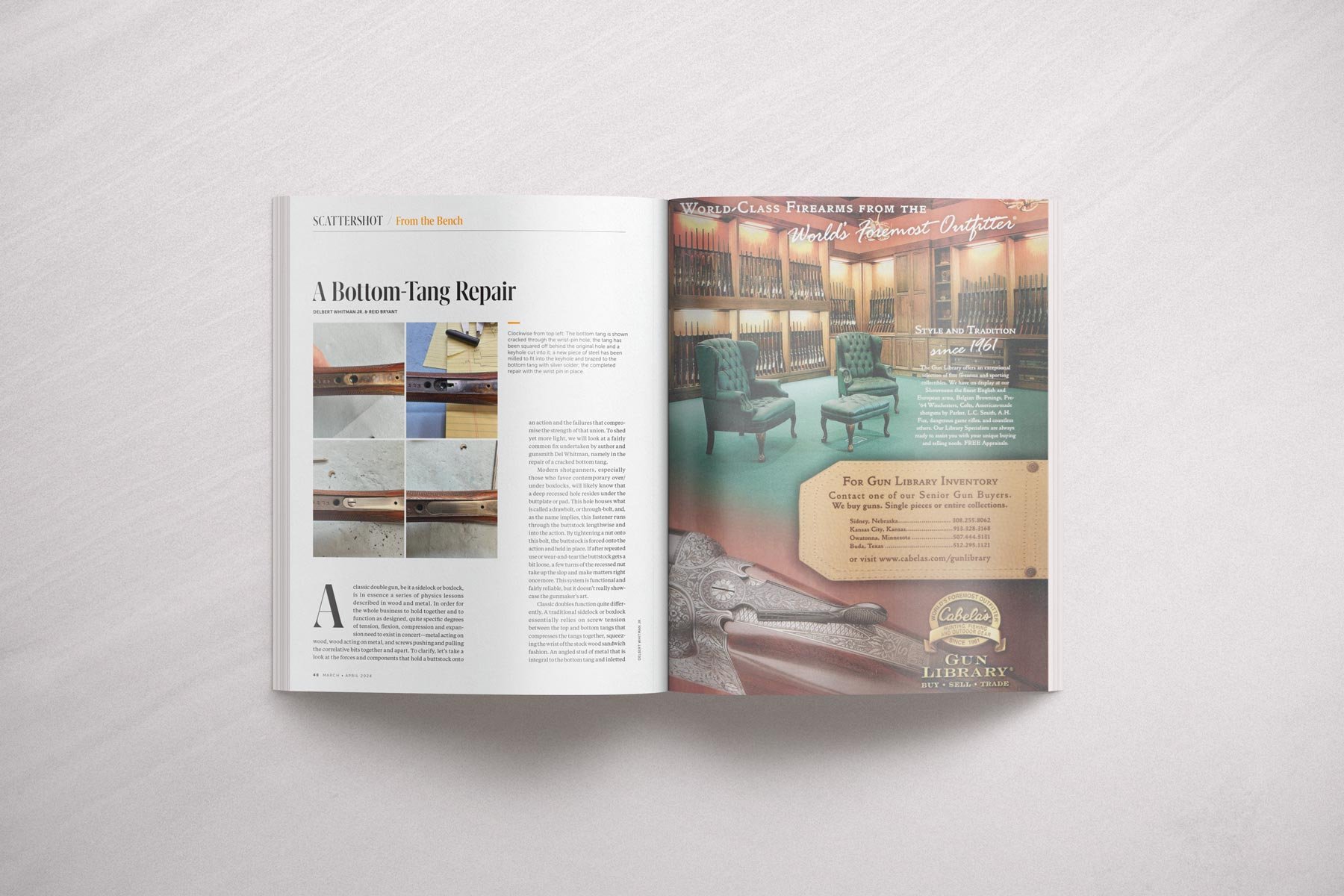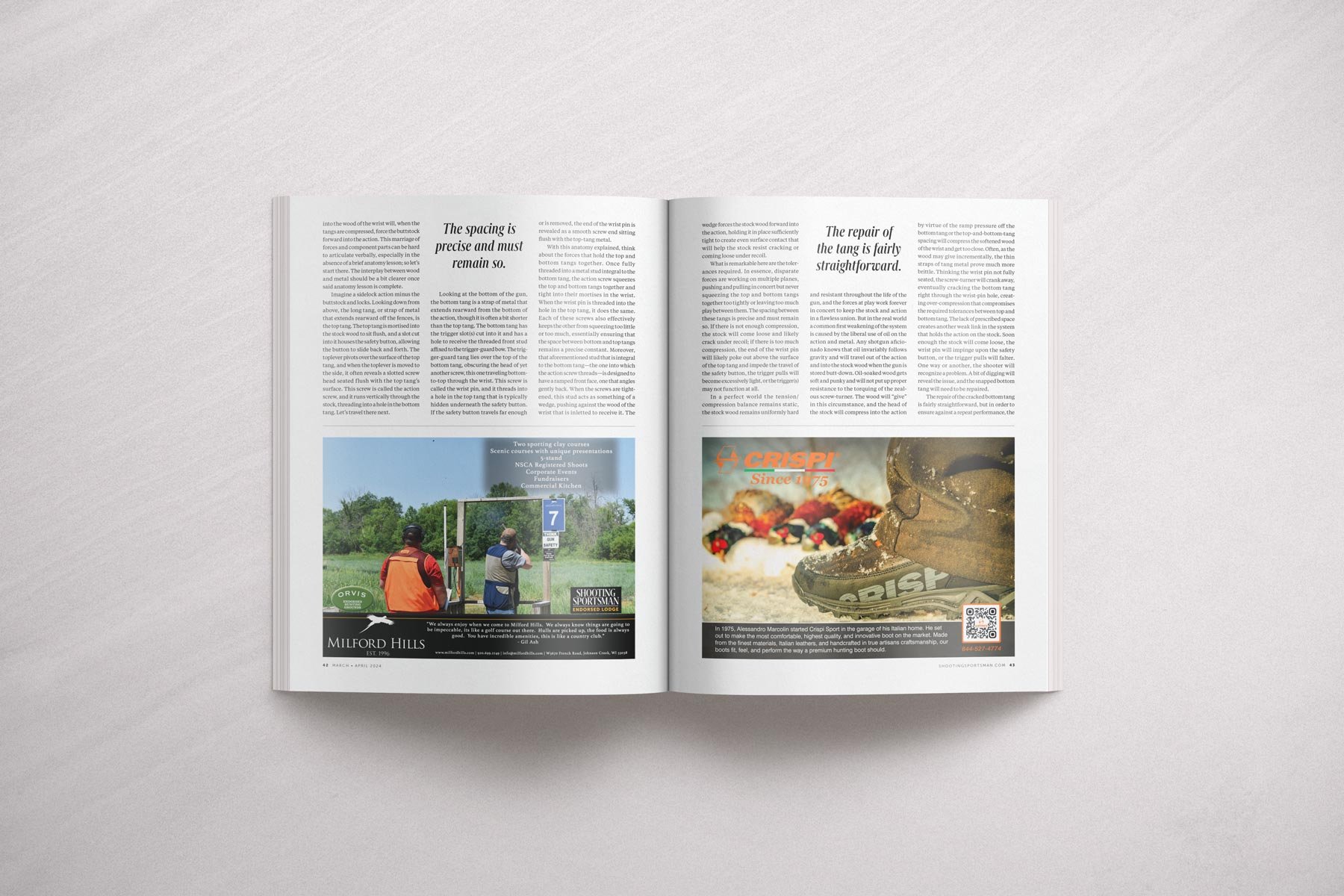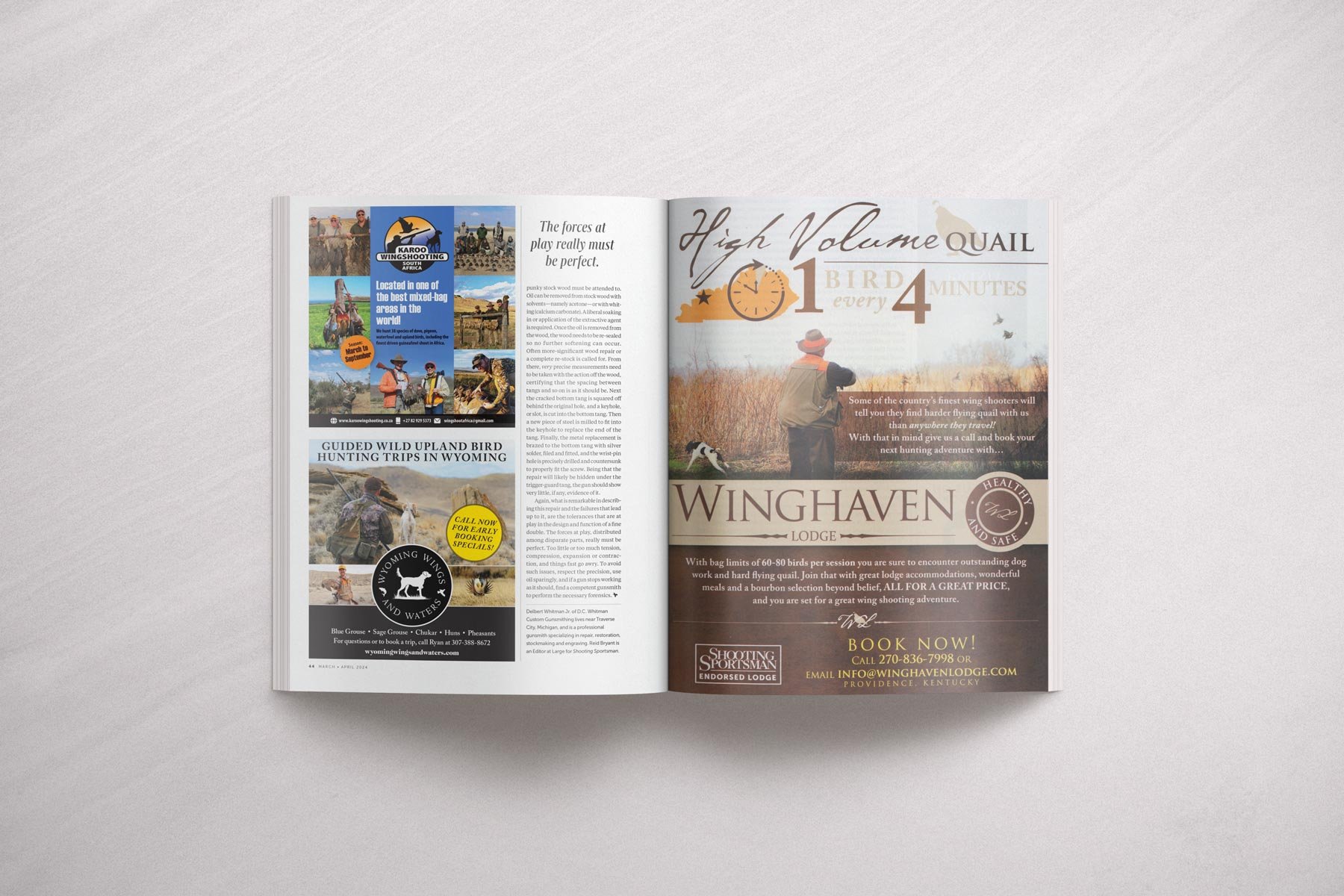A Bottom-Tang Repair
A classic double gun, be it a sidelock or a boxlock, is in essence a series of physics lessons described in wood and metal. In order for the whole business to hold together and to function as designed, quite specific degrees of tension, flexion, compression and expansion need to exist in concert—metal acting on wood, wood acting on metal, and screws pushing and pulling the correlative bits together and apart. To clarify, let’s take a look at the forces and components that hold a buttstock onto an action and the failures that compromise the strength of that union. To shed yet more light, we will look at a fairly common fix undertaken by author and gunsmith Del Whitman, namely in the repair of a cracked bottom tang.
Modern shotgunners, especially those who favor contemporary over/under boxlocks, will likely know that a deep recessed hole resides under the buttplate or pad. This hole houses what is called a drawbolt, or through-bolt, and, as the name implies, this fastener runs through the buttstock lengthwise and into the action. By tightening a nut onto this bolt, the buttstock is forced onto the action and held in place. If after repeated use or wear-and-tear the buttstock gets a bit loose, a few turns of the recessed nut take up the slop and make matters right once more. This system is functional and fairly reliable, but it doesn’t really showcase the gunmaker’s art.
Classic doubles function quite differently. A traditional sidelock or boxlock essentially relies on screw tension between the top and bottom tangs that compresses the tangs together, squeezing the wrist of the stock wood sandwich fashion. An angled stud of metal that is integral to the bottom tang and inletted into the wood of the wrist will, when the tangs are compressed, force the buttstock forward into the action. This marriage of forces and component parts can be hard to articulate verbally, especially in the absence of a brief anatomy lesson; so let’s start there. The interplay between wood and metal should be a bit clearer once said anatomy lesson is complete.
Imagine a sidelock action minus the buttstock and locks. Looking down from above, the long tang, or strap of metal that extends rearward off the fence(s), is the top tang. The top tang is mortised into the stock wood to sit flush, and a slot cut into it houses the safety button, allowing the button to slide back and forth. The toplever pivots over the surface of the top tang, and when the toplever is moved aside, it often reveals a slotted screwhead seated flush with the top tang’s surface. This screw is called the action screw, and it runs vertically through the stock, threading into a hole in the bottom tang. Let’s travel there next.
Looking at the bottom of the gun, the bottom tang is a strap of metal that extends rearward from the bottom of the action, though it is often a bit shorter than the top tang. The bottom tang has the trigger slot(s) cut into it and has a hole to receive the threaded front stud affixed to the trigger-guard bow. The trigger-guard tang lies over the top of the bottom tang, obscuring the head of yet another screw, this one traveling bottom-to-top through the wrist. This screw is called the wrist pin, and it threads into a hole in the top tang that is typically hidden underneath the safety button. If the safety button travels far enough or is removed, the end of the wrist pin is revealed as a smooth screw end sitting flush with the top-tang metal.
With this anatomy explained, think about the forces that hold the top and bottom tangs together. Once fully threaded into a metal stud integral to the bottom tang, the action screw squeezes the top and bottom tangs together and tight into their mortises in the wrist. When the wrist pin is threaded into the hole in the top tang, it does the same. Each of these screws also effectively keeps the other from squeezing too little or too much, essentially ensuring that the space between bottom and top tangs remains a precise constant. Moreover, that aforementioned stud that is integral to the bottom tang—the one into which the action screw threads—is designed to have a ramped front face, one that angles gently back. When the screws are tightened, this stud acts as something of a wedge, pushing against the wood of the wrist that is inletted to receive it. The wedge forces the stock wood forward into the action, holding it in place sufficiently tight to create even surface contact that will help the stock resist cracking or coming loose under recoil.
What is remarkable here is the tolerances required. In essence, disparate forces are working on multiple planes, pushing and pulling in concert but never squeezing the top and bottom tangs together too tightly or leaving too much play between them. The spacing between these tangs is precise and must remain so. If there is not enough compression, the stock will come loose and likely crack under recoil; if there is too much compression, the end of the wrist pin will likely poke out above the surface of the top tang to impede the travel of the safety button, the trigger pulls will become excessively light or the trigger(s) may not function at all.
In a perfect world the tension/compression balance remains static, the stock wood remains uniformly hard and resistant throughout the life of the gun, and the forces at play work forever in concert to keep the stock and action in a flawless union. But in the real world a common first weakening of the system is caused by the liberal use of oil on the action and metal. Any shotgun aficionado knows that oil invariably follows gravity and will travel out of the action and into the stock wood when the gun is stored butt-down. Oil-soaked wood gets soft and punky and will not put up proper resistance to the torquing of the zealous screw-turner. The wood will “give” in this circumstance, and the head of the stock will compress into the action by virtue of the ramp pressure off the bottom tang or the top-and-bottom-tang spacing will compress the softened wood of the wrist and get too close. Often, as the wood may give incrementally, the thin straps of tang metal prove much more brittle. Thinking the wrist pin not fully seated, the screw-turner will crank away, eventually cracking the bottom tang right through the wrist pin hole, creating over-compression that compromises the required tolerances between top and bottom tang. The lack of prescribed space creates another weak link in the system that holds the action on the stock. Soon enough the stock will come loose, the wrist pin will impinge upon the safety button, or the trigger pulls will falter. One way or another, the shooter will recognize a problem. A bit of digging will reveal the issue, and the snapped bottom tang will need to be repaired.
The repair of the cracked bottom tang is fairly straightforward, but in order to ensure against a repeat performance, the punky stock wood must be attended to. Oil can be removed from stock wood with solvents—namely acetone—or with whiting (calcium carbonate). A liberal soaking in or application of the extractive agent is required. Once the oil is removed from the wood, the wood needs to be re-sealed so no further softening can occur. Often more-significant wood repair or a complete re-stock is called for. From there, very precise measurements need to be taken with the action off the wood, certifying that the spacing between tangs and so on is as it should be. Next the cracked bottom tang is squared off behind the original hole, and a keyhole or slot is cut into the bottom tang. Finally a new piece of steel is milled to fit into the keyhole to replace the end of the tang. The metal replacement is braised to the bottom tang with silver solder, filed or milled to measure, and finished. Being that the repair will likely be hidden under the trigger-guard tang, the gun should show very little, if any, evidence of it.
What is remarkable, however, in describing this repair and the failures that lead up to it, is the tolerances that are at play in the design and function of a fine double. The forces at play, distributed among disparate parts, really must be perfect. Too little or too much tension, compression, expansion or contraction, and things fast go awry. To avoid such issues, respect the precision, use oil sparingly, and if a gun stops working as it should, find a competent gunsmith to perform the necessary forensics.
First Published in Shooting Sportsman



